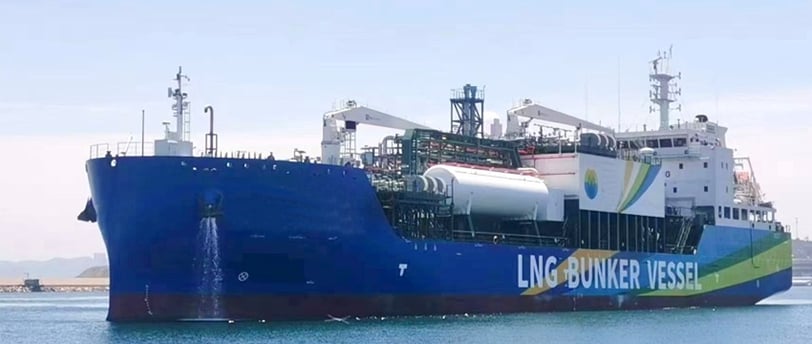LBV - LNG Bunkering Vessel For Long-Term Charter
Suitable for worldwide service transporting LNG and bunkering LNG to other ships
7/30/20242 min read


Vessel Information :
Year Built: 2022
LOA: 119 meters
Breath: 19.8 meters
Design draft: 5.9 meters
Service speed: 13.5 knots
Total volume of cargo tanks: 8,500 m3
Deep well cargo pump, max. LNG bunkering rate:1,500m³/h
LBV Technical Features is as below:
- Cryogenic LNG Cargo (-162℃) storage, same as LNGC. (Loading / Bunkering)
- Equipped STS equipment for LNG transfer, and set up STS hosed to LFV.
- Handling Excess BOG, not only from LBV cargo tank but also LFV side.
- Measure LNG composition and flow, and issue BDN (Bunker Delivery Note)
- Equip Fenders and Mooring equipment for STS mooring
- Maneuvering ability inside port, and approach to LFV without collision
- Communication tool between Terminal & LBV & LFV (SSL / USL / ESL)
- Supply Dry/Inert/Gassing-up/LNG loading services for LNGC
#LNG #LNGBUNKERING #LNGTRANSPORT #LNGCHARTER #LNGLEASE #LNGBUNKERVESSEL #BUNKER #BUNKERING
A Quick Read
Introduction to LBV: Revolutionizing Maritime Fueling
The maritime industry is undergoing significant changes, particularly in terms of fueling solutions. One of the most prominent advancements is the use of LNG Bunkering Vessels (LBVs) for long-term charter. These vessels are designed specifically for worldwide service, transporting liquefied natural gas (LNG) and bunkering LNG to other ships, offering a more efficient and sustainable solution.
Benefits of Using LBVs
The use of LBVs introduces several advantages over traditional fueling methods. Firstly, LNG as a fuel source is considerably cleaner than conventional marine fuels, leading to a reduction in greenhouse gas emissions. This aligns with global environmental regulations and the industry's move towards more sustainable practices. Additionally, the flexibility of LBVs enables them to service a wide range of vessels globally, making them a versatile option for long-term operations.
Operational Efficiency of LNG Bunkering Vessels
LBVs play a crucial role in enhancing operational efficiency within the maritime sector. These vessels ensure a reliable supply of LNG, minimizing downtime for other ships that require refueling. Advanced onboard systems allow for precise monitoring and handling of LNG, ensuring maximum safety and efficiency during bunkering operations. This operational efficiency translates to cost savings for operators and increased reliability in fuel supply chains.
LBVs in the Global Fleet: A Growing Trend
As the demand for LNG-fueled ships continues to rise, the presence of LBVs in the global fleet is expanding. Shipping companies are increasingly opting for long-term charters of LBVs to ensure uninterrupted access to LNG. This trend is not only a testament to the growing popularity of LNG as a maritime fuel but also highlights the maritime industry's proactive approach to adopting cleaner and more efficient technologies.
Conclusion: Embracing the Future with LBVs
The introduction of LBVs for long-term charter marks a significant milestone in the maritime industry's journey towards sustainability and efficiency. By facilitating the transportation and bunkering of LNG worldwide, these vessels are paving the way for a cleaner, more resilient future in maritime operations. As the global fleet continues to embrace LNG and LBVs, the industry will undoubtedly benefit from reduced environmental impact and enhanced operational capabilities.
Altus TecQuip
Specializing in cargo grabs buckets and marine equipment.
CONTACT
ENQUIRY
© 2024. All rights reserved.
